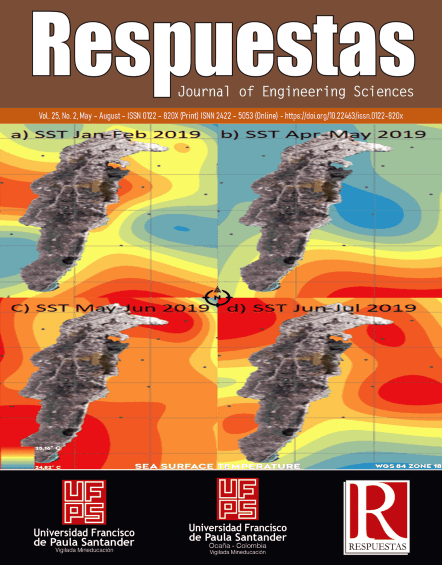Comportamiento en la curva de la corriente eléctrica cambiando el área de anodizado
Behavior in the electric current curve by changing the anodizing area
Contenido principal del artículo
En este trabajo se estudió en el cambio en la corriente eléctrica y la longitud de los nanotubos en función del área y del tiempo de exposición en el proceso de anodización. Con el tiempo se fue cambiando el área de anodizado con una tasa de 0.5 cm2 hasta 2.5 cm2 empleando un tiempo total de anodizado de 60 min, utilizando una disolución química (2ml /3 ml /0.30 g ) y manteniendo un voltaje de anodización constante igual a 20 V. El comportamiento en las nonoestructuras se registró mediante la evolución de la densidad de corriente en función del tiempo de anodizado. La morfología de las nanoestructuras se analizó por medio de microscopía electrónica de barrido (MEB). Con el uso del programa Imagej. Se obtiene el tamaño, longitud y diámetro de las nonoestructuras de Titanio. La muestra que ha presentado el mejor comportamiento fue la de una área de anodizado de 1.5 cm2 y un tiempo de anodizado de 36 min. Esta, presenta, una superficie donde se observan nanotubos abiertos en la parte superior con una longitud vertical de 0.23 μm y un patrón de los mismos organizado en una disposición circular con un diámetro de 0.035 μm. Se observó que al aumentar el área en estas condiciones de anodizado disminuía la longitud de los nanotubos. La movilidad de las cargas siempre fue mayor con el área de exposición lo cual se observa en el aumento de la corriente
Descargas
Detalles del artículo
Z. W. Pan, Z. R. Dai, Z. L. Wang, “Nanobelts of Semiconducting Oxides”. Science, vol. 291, pp. 1947-1949, 2001. doi10.1126/science.1058120.
J.M. Macak, P. Schmuki, “Anodic Growth of Self-Organized Anodic TiO2 Nanotubes in Viscous Electrolytes”. Electrochimica Acta, Vol.52,pp.1258-1264,2006. doi:10.1016/j.electacta.2006.07.021 .
Z. W. Pan, Z. R. Dai, Z. L. Wang, “Lead oxide nanobelts and phase transformation induced by electron beam irradiation”. Appl Phys Lett., vol. 80, pp. 309,2002. doi:10.1063/1.1432749 .
C. Li, G. Fang, S. Xu, D. Zhao, X. Zhao, “Phase-segregation assisted growth of quasi-aligned ZnO nanorods on a Mg0.6Zn0.4O-coated Si substrate by thermal evaporation”. Nanotechnology, vol. 17, no 21, 2006. doi:10.1088/0957-4484/17/21/014 .
Gorun Butail, P.G. Ganesan, M. Raddiar, R. Teki, N. Ravishankar, D.J. Duquette, Ganpati Ramanath, “Kinetics of titania nanotube formation by anodization of titanium films ”. Thin Solid Films, vol. 519, pp. 1821–1824, 2011. doi:10.1016/j.tsf.2010.10.004 .
Y.R. Ma, C.C. Tsai, S.F. Lee, K.W. Chen, Y. Liou,Y.D. Yao, “Magnetic properties of large-area one-dimensional WO2 and MoO2 nanorods”. J. Magn. Magn. Mater, vol. 304, pp. e13-e15, 2006. doi:10.1016/j.jmmm.2006.02.025 .
R.S. Devan, W.D. Ho, J.H. Lin, S.Y. W, Y.R. Ma, P.C. Lee, Y. Liou, “X-ray Diffraction Study of a Large-Scale and High-Density Array of One-Dimensional Crystalline Tantalum Pentoxide Nanorods”. Crystal Growth & Design, vol. 8 no. 12, pp. 4465-4468, 2008. doi:10.1021/cg800369s.
K. Nagashima, T. Yanagida, H. Tanaka, T. Kawai, “Interface effect on metal-insulator transition of strained vanadium dioxide ultrathin films”. J. Appl. Phys., vol. 101, 2007. doi:10.1063/1.2424321.
Y.R. Ma, C.M. Lin , C.L. Yeh , R.T. Huang, “Synthesis and characterization of one-dimensional WO2 nanorods”. Vac. Sci. Technol. B., vol. 23, 2005. https://doi.org/10.1116/1.2050668.
L. Young, Anodic Oxide Films, Academic Press London und New York, 1961.
D. A. Vermilyea, “Anodic Films in Advances in Electrochemistry and Electrochemical Engineering”. Interscience, vol. 3, pp. 248, 1963.
C.J. Brinker, G.W. Scherer, “The physics and Chemistry of Sol-Gel Processing”. Academic Press Sol-Gel Science, 1990.
L.L. Hench, J.K. West, “The sol-gel process”. Chem. Rev, vol. 90, pp. 33-72, 1990.
M.M.Lohrengel, “Thin anodic oxide layers on aluminium and other valve metals: high field regime”. Materials Science and Engineering: R: Reports, vol.11, pp. 243-294, 1986. doi:10.1016/0927-796x(93)90005-n
E.J.W. Verwey, “Electrolytic conduction of a solid insulator at high fields The formation of the anodic oxide film on aluminium”. Physc, vol. 2 no. 1-12, pp. 1059-1063, 1935. doi:10.1016/s0031-8914(35)90193-8
F Redondo Quintela, Roberto C. Redondo Melchor -, Electrostática y Corriente Eléctrica para Ingenieros, STS EDICIONES,,232 ,2019.
H. M. Mateus , J. Bautista-Ruiz , J.Barba-Ortega and M. R.Joya,” Formation of Titanium oxide nanotube arrays by controlling H2O and time through anodic oxidation” Rasyan. J. Chem.12, |1304 – 1314,2019. http://dx.doi.org/10.31788/RJC.2019.1235265.
K.J. Vetter, “Electrochemical Kinetics: Theoretical Aspects”. Springer-Verlag, 1967.
D.D. DeFord, “Electroanalysis and Coulometric Analysis”. Anal. Chem., vol. 30, pp. 613-619, 1960. https://doi.org/10.1021/ac60161a604.
C. Vanleugenhage, J. Van Muylder, N. De Zoubov, M. Pourbaix, J. Besson, W. Kunz, K. Schwabe, “Contribution a l'etablissement d'un atlas d'equilibres electrochimiques”. Electrochim. Acta, vol. 1, pp. 349-353, 1959. doi:10.1016/0022-0728(60)85048-6 .
C.G. Zoski, “Handbook of Electrochemistry”. Elsevier, 2007.
J.W. Schultze, “Stability, reactivity and breakdown of passive films. Problems of recent and future research”. 5.1. Electrochimica Acta, vol 45, pp. 2499-2513, 2000. doi:10.1016/s0013-4686(00)00347-9 .
P. Schmuki, “From Bacon to barriers: a review on the passivity of metals and alloys”. J. Solid State Electrochem, vol 6, pp. 145-164, 2002. doi:10.1007/s100080100219 .
E. Horwood, “Instrumental Methods in Electrochemistry”, Halsted Press, 1985.
J. Tafel, Z. “Über die Polarisation bei kathodischer Wasserstoffentwicklung ”. Physik. Chem, vol. 50, pp. 641, 1905. doi:10.1515/zpch-1905-5043
H. Masuda, K. Fukuda, “Ordered Metal Nanohole Arrays Made by a Two-Step Replication of Honeycomb Structures of Anodic Alumina ”. Science, vol. 268, pp. 1466-1468, 1995. doi:10.1126/science.268.5216.1466.
N. Khalil, J.S. Leach, “The anodic oxidation of valve metals—I. Determination of ionic transport numbers by α-spectrometry”. Electrochim. Acta, vol.31, pp. 1279-1285, 1986. doi:10.1016/0013-4686(86)80148-7 .
K. Yasuda, J.M. Macak, S. Berger, A. Ghicov, P. Schmuki, J. “Mechanistic Aspects of the Self-Organization Process for Oxide Nanotube Formation on Valve Metals”. J Electrochem Soc, vol.154, pp.C472. 2007. doi:10.1149/1.2749091 .
Zhang, K., Cao, S., Li, C., Qi, J., Jiang, L., Zhang, J., Zhu, X. Rapid growth of TiO2 nanotubes under the compact oxide layer: Evidence against the digging manner of dissolution reaction. Electrochemistry Communications, 103, 2019. doi:10.1016/j.elecom.2019.05.015
P. A. Marques, K. F. Albertin, G. Z. Monteiro, I. Pereyra,Optimized synthesis for improved TiO2 NT array surface, Cerâmica vol.65 ,pag.327-334,2019. doi:10.1590/0366-69132019653752583




 Perfil Google Scholar
Perfil Google Scholar



